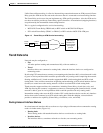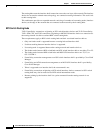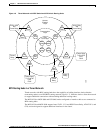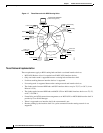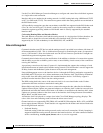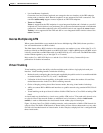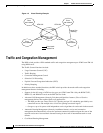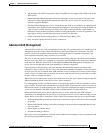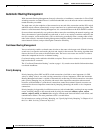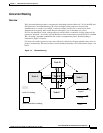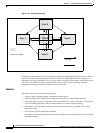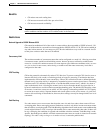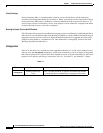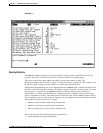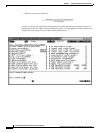
1-21
Cisco BPX 8600 Series Installation and Configuration
Release 9.3.10, Part Number 78-11603-01 Rev. D0, July 2001
Chapter 1 The BPX Switch: Functional Overview
Traffic and Congestion Management
• Abr Standard with VSVD; congestion control using RM cells and supported by BXM cards on the
BPX Switch.
• Optimized Bandwidth Management (formerly ForeSight), an end-to-end closed loop rate based
congestion control algorithm that dynamically adjusts the service rate of VC queues based on
network congestion feedback.
• Dynamic Buffer Management, Cisco’s Frame Relay and ATM service modules are equipped with
large buffers and a dynamic buffer management technique for allocating and scaling the buffers on
a per VC basis to traffic entering or leaving a node. The switch dynamically assigns buffers to
individual virtual circuits based on the amount of traffic present and service level agreements. The
large queues readily accommodate large bursts of traffic into the node.
• PNNI, a standards-based routing protocol for ATM and Frame Relay SVCs.
• Early and partial packet discard for AAL5 connections.
Advanced CoS Management
Advanced Class of Service (CoS) management provides per-VC queueing and per-VC scheduling. CoS
management provides fairness between connections and firewalls between connections. Firewalls
prevent a single non-compliant connection from affecting the QoS of compliant connections. The
non-compliant connection simply overflows its own buffer.
The cells received by a port are not automatically transmitted by that port out to the network trunks at
the port access rate. Each VC is assigned its own ingress queue that buffers the connection at the entry
to the network. With Abr with VSVD or with Optimized Bandwidth Management (ForeSight), the
service rate can be adjusted up and down depending on network congestion.
Network queues buffer the data at the trunk interfaces throughout the network according to the
connection’s Class of Service. Service classes are defined by standards-based QoS. Classes can consist
of the five service classes defined in the ATM standards as well as multiple sub-classes to each of these
classes. Classes can range from constant bit rate services with minimal cell delay variation to variable
bit rates with less stringent cell delay.
When cells are received from the network for transmission out a port, egress queues at that port provide
additional buffering based on the Service Class of the connection.
CoS management provides an effective means of managing the Quality of Service defined for various
types of traffic. It permits network operators to segregate traffic to provide more control over the way
that network capacity is divided among users. This is especially important when there are multiple user
services on one network. The BPX switch provides separate queues for each traffic class.
Rather than limiting the user to the five broad classes of service defined by the ATM standards
committees, CoS management can provide up to 16 classes of service (service subclasses) that you can
further define and assign to connections. Some of the COS parameters that may be assigned include:
• Minimum bandwidth guarantee per subclass to assure that one type of traffic will not be preempted
by another.
• Maximum bandwidth ceiling to limit the percentage of the total network bandwidth that any one
class can utilize.
• Queue depths to limit the delay.
• Discard threshold per subclass.
These class of service parameters are based on the standards-based Quality of Service parameters and
are software programmable by the user.



